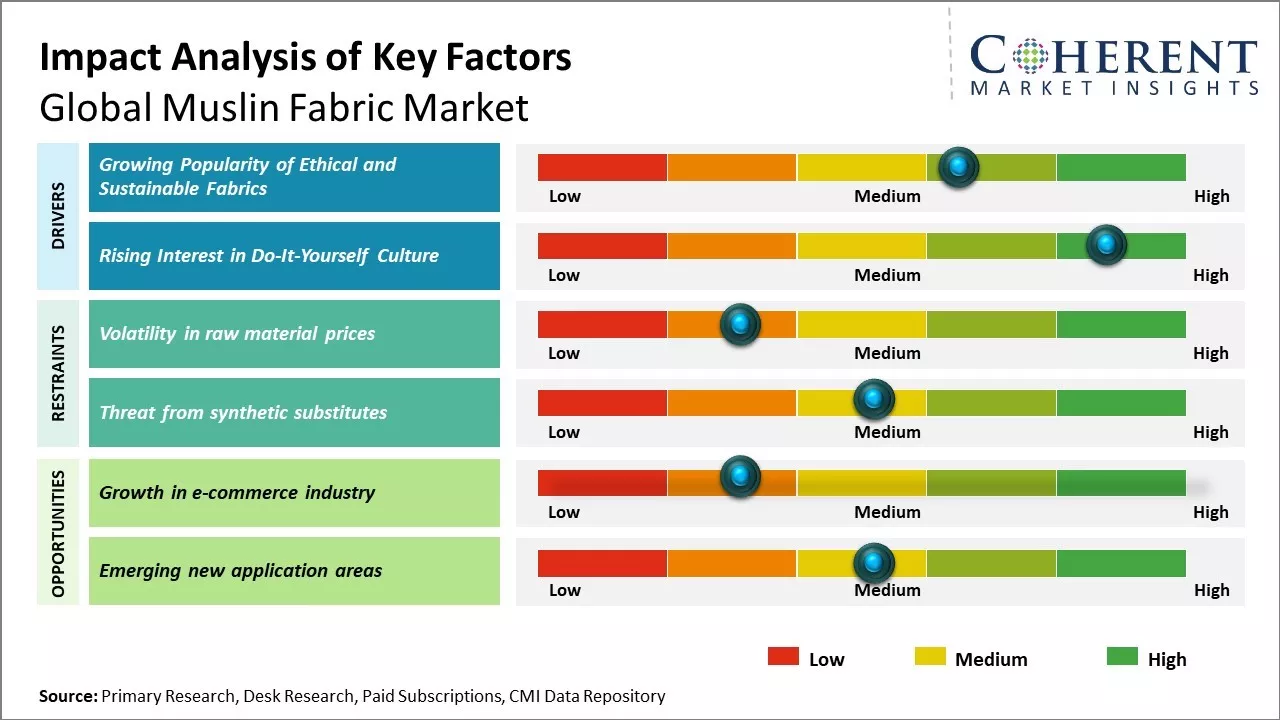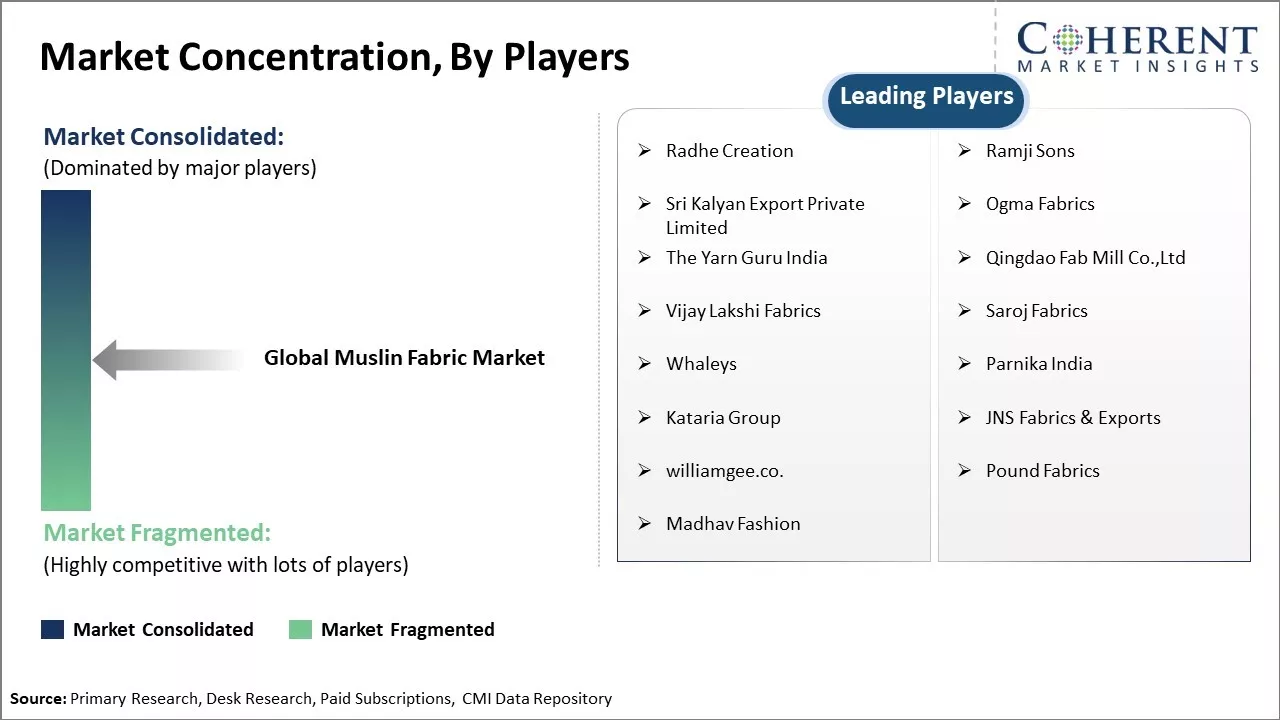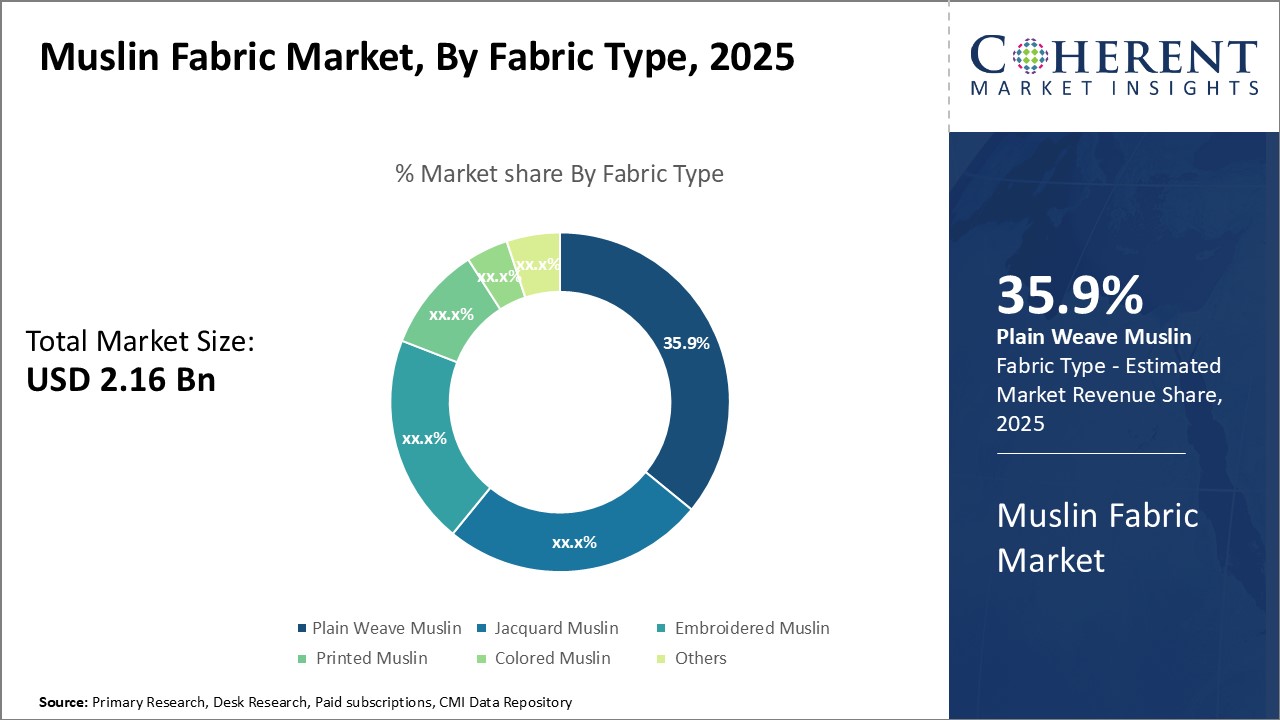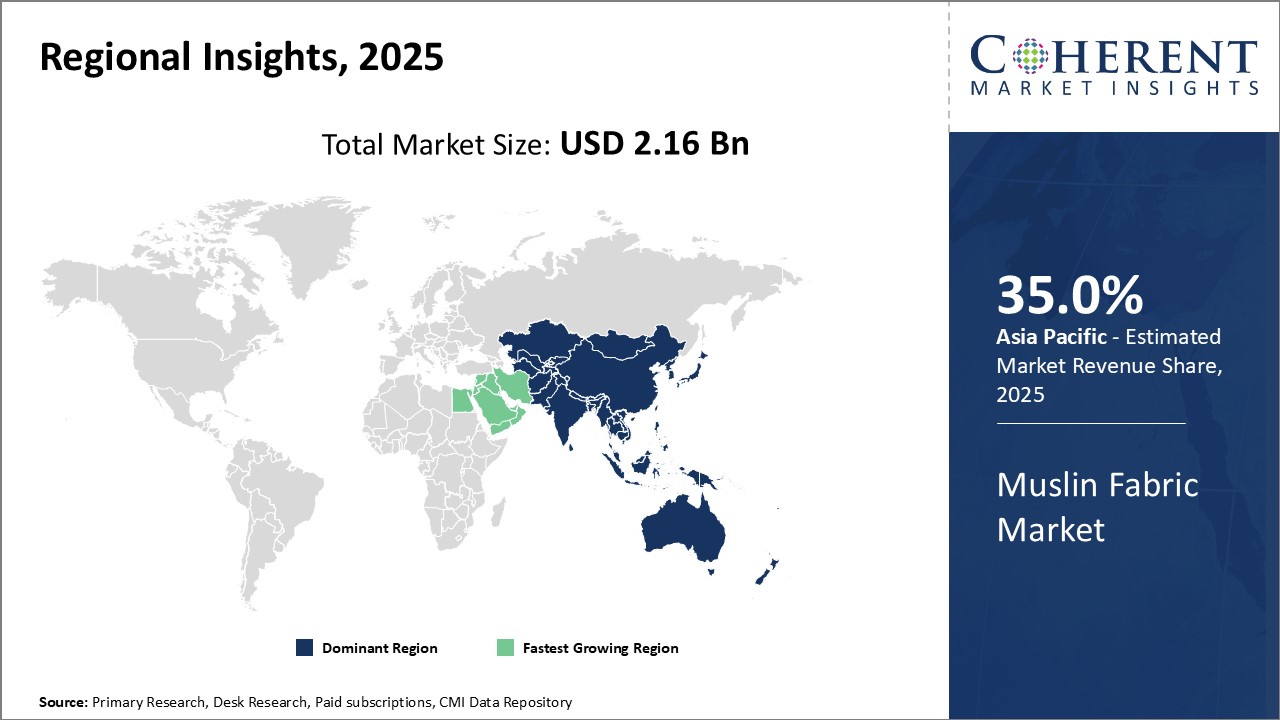Muslin Fabric Market Size and Trends
The muslin fabric market is estimated to be valued at USD 2.16 Bn in 2025 and is expected to reach USD 3.34 Bn by 2032, exhibiting a compound annual growth rate (CAGR) of 6.4% from 2025 to 2032.

Discover market dynamics shaping the industry: Download Free Sample
The market is expected to witness steady growth during the forecast period. Major players are launching new products to cater to the rapidly growing demand from consumers. Players operating in the market are investing in research & development to come up with new and innovative products to strengthen their market position.
Growing Popularity of Ethical and Sustainable Fabrics
The increasing focus on environmentalism and sustainability has boosted the demand for muslin fabric in recent years. Known for being an eco-friendly material that is both sustainable to produce and easy on the environment, muslin is well-positioned to benefit from the global shift toward more ethical consumerism. Many consumers, especially younger generations, are now paying closer attention to the impacts of their purchasing decisions and actively seeking out brands and products that align with their values. With its natural fibers and production process that avoids synthetic chemicals, muslin satisfies the criteria for an earth-friendly textile. This consumer demand for sustainable options has contributed to muslin’s expansion beyond its traditional uses. Where it once played a more limited role mainly in the apparel industry, muslin is penetrating a growing range of end markets. Home goods makers have incorporated muslin for décor accessories like pillows and curtains to attract customers prioritizing the environment. The material has also found footing in the booming wellness sphere. Yoga studios favor muslin for exercise mats and other equipment given its breathable qualities in addition to the sustainable attributes. Overall, muslin has elegantly positioned itself at the intersection of functionality and ethics, resonating strongly with modern lifestyles that emphasize wellness, eco-friendliness and socially-minded purchasing.
Market Concentration and Competitive Landscape

Get actionable strategies to beat competition: Download Free Sample
Rising Interest in Do-It-Yourself Culture
Another driver propelling the muslin fabric market has been the flourishing do-it-yourself movement. As busy schedules leave less time for leisure activities, many find solace and satisfaction in DIY home projects that allow for creative expression. Social media has amplified this trend by spreading stylish project ideas and a can-do attitude to audiences of all skill levels. Muslin fabric has emerged as a go-to material for beginners diving into arts and crafts. Its low cost and wide availability make muslin easily accessible. Just as importantly, its forgiving nature means mistakes do not show as clearly compared to other fabrics. DIYers embracing stamping, embroidery, stenciling, and quilting feel confident experimenting with muslin given the room for error. Popular online tutorials centered around muslin have inspired crafters across all demographics to give projects a try.
Key Takeaways of Analyst:
The global muslin fabric market is expected to witness steady growth over the next five years. The market is driven by the increasing demand for muslin fabrics in developing regions of Asia Pacific and Middle East & Africa. Countries like India, Pakistan, and Bangladesh are large producers and consumers of muslin owing to its breathable properties suiting the hot climate.
Easy availability and affordable prices have made muslin a popular choice for daily wear clothing in these regions. Growing populations and rising disposable incomes are likely to sustain this demand.
Cheap synthetic substitutes posing stiff competition could restrain the market growth. Also, developed markets might see slower uptake as customers focus on high-end apparel. Nevertheless, emerging applications in industrial sectors such as healthcare present new opportunities. The growing demand for breathable fabrics in medical apparel and hospital linen is opening new avenues. Furthermore, increasing popularity of muslin bed sheets and curtains in home décor segment also bodes well for the market.
Market Challenges: Volatility in raw material prices
Volatility in raw material prices has severely impacted the global muslin fabric market in recent years. Muslin fabric is primarily made from cotton which is heavily dependent on agricultural crops. Cotton farming is susceptible to various factors like changing weather patterns, monsoon failures, pest attacks etc which have led to fluctuation in cotton yields. Any reduction in cotton output directly leads to increase in cotton prices as demand remains stable.
Market Opportunities: Growth in e-commerce industry
The rise of e-commerce provides immense opportunities for growth in the global muslin fabric market. As more people do their shopping online, they are exposed to a wider variety of products from all over the world. This greater exposure allows traditionally lesser known fabrics like muslin to reach new customers. E-commerce provides an accessible global platform for muslin fabric producers and sellers. They can market directly to consumers without being limited by geographical boundaries or the constraints of operating physical retail stores. Online marketplaces give visibility to artisanal muslin fabrics produced using traditional techniques in different parts of Asia and Africa. Customers appreciate understanding the origins and craft of what they buy. The cultural stories behind handmade muslin appeal to many online shoppers.

Discover high revenue pocket segments and roadmap to it: Download Free Sample
Insights by Fabric Type: Dominating the Muslin Fabric Market
Plain weave muslin fabric is expected to contribute 35.9% share of the muslin fabric market in 2025, owing to its simplicity and versatility. As a basic muslin weave without any textures or patterns, plain weave muslin is the easiest to produce, making it very cost effective. This allows plain weave muslin to be affordable for a wide range of end uses. Its simple construction also makes plain weave muslin durable and hardwearing. Whether being used for apparel, home textiles, or industrial applications, plain weave muslin can withstand heavy usage and regular washing or cleaning. Plain weave muslin's versatility stems from its lack of distinctive textures or designs. This means it can be easily incorporated into any design scheme or style. For apparel, plain weave muslin takes color well and is suitable for everything from casual everyday wear to more formal styles. It is a popular base fabric for digital, screen, or heat transfer printing to create designs. In home textiles, plain weave muslin's subtlety allows it to blend in seamlessly with both traditional and modern interior decors in any room of the home. Its unpatterned surface also makes plain weave muslin well-suited for light industrial applications such as bag filters or protective covers. Besides affordability and durability, plain weave muslin's breathability has further elevated its appeal. The open plain weave structure allows excellent airflow, keeping the wearer cool in warm climates. This makes plain weave muslin a top choice for hot weather apparel and home textiles. Its moisture-wicking ability also helps wearers feel dry. As synthetic fabrics rise in use, consumers are increasingly preferring the natural breathability and sweat absorption of plain weave muslin. Sustainable and eco-friendly attributes have amplified plain weave muslin's market share growth over other muslin varieties.
Insights by End-Use Industry: The Dominant End-Use Industry for Muslin Fabric
The apparel contributes the 35.1% share of the muslin fabric market in 2025, owing to muslin's suitability for a wide variety of garments. Muslin is inexpensive yet durable, making it perfect for basic everyday wear like tops, dresses, and trousers. Its lightweight breathability also finds favor for warm weather clothing. Muslin is widely used to make simple solid-colored tees, shirts, skirts and pants that never go out of style. The plain weave muslin is commonly used as the base material for digital printing to create custom apparel design on demand. Besides casualwear, muslin is also utilized for certain formal apparel such as dress shirts and blouses due to its excellent drape and smooth handfeel. Its subtle texture works well for layered outfit pieces. In traditional clothing markets, muslin remains a top pick for making kurtas, tunics, salwar kameez and other ethnic garments. The sustainability of muslin further attracts environmentally-conscious apparel brands. Its natural breathability and quick-drying capability suit activewear lines well. Muslin production also supports numerous small and medium textile industries worldwide. The pandemic has accelerated muslin fabric's apparel market dominance with more people prioritizing breathable, comfortable stay-at-home clothing options. Its softness makes muslin well-liked for sleep and loungewear too. With rising health awareness, consumers are increasingly opting for natural muslin over synthetic blends in their wardrobes as well. Greater fashion trends of relaxed silhouettes and layered separates too have amplified muslin popularity in apparels in recent years. All these factors will likely keep propelling muslin's use in the multi-billion dollar global apparel industry.
Regional Insights

Need a Different Region or Segment? Download Free Sample
The Asia Pacific region has emerged as the dominant player in the global muslin fabric market, accounting for a significant 35.0% of the market share in 2025. Countries like India, China, and Bangladesh have well-established textile manufacturing hubs that specialize in producing high-quality muslin fabrics. The availability of skilled labor, advanced production technologies, and competitive pricing have made Asia Pacific a preferred sourcing destination for global apparel brands. The region's large population, rising disposable incomes, and growing fashion consciousness have driven the demand for muslin-based apparel and home furnishings. Consumers in Asia Pacific appreciate the lightweight, breathable, and comfortable properties of muslin fabric, making it a popular choice for summer and year-round use. Governments in the region have implemented supportive policies to encourage textile exports, including tax incentives, infrastructure development, and investment in research and development. These initiatives have further bolstered the growth of the muslin fabric market in Asia Pacific.
The Middle East and Africa region is emerging as the fastest-growing market for muslin fabrics. Consumers in the Middle East and Africa are becoming increasingly aware of the benefits of muslin fabric owing to its breathability, softness, and versatility. This growing preference for natural and sustainable fabrics is fueling the demand for muslin-based products in the region. The development of modern retail infrastructure, including shopping malls and e-commerce platforms, has improved product availability and consumer accessibility to muslin fabrics in the region. Economic growth and rising disposable incomes in countries like the U.A.E, Saudi Arabia, and South Africa have enabled consumers to spend more on lifestyle and fashion products including muslin-based apparel and home textiles.
Market Report Scope
Muslin Fabric Market Report Coverage
| Report Coverage | Details | ||
|---|---|---|---|
| Base Year: | 2024 | Market Size in 2025: | USD 2.16 Bn |
| Historical Data for: | 2020 To 2024 | Forecast Period: | 2025 To 2032 |
| Forecast Period 2025 to 2032 CAGR: | 6.4% | 2032 Value Projection: | USD 3.34 Bn |
| Geographies covered: |
|
||
| Segments covered: |
|
||
| Companies covered: |
Radhe Creation, Ramji Sons, Sri Kalyan Export Private Limited, Ogma Fabrics, The Yarn Guru India, Qingdao Fab Mill Co.,Ltd, Vijay Lakshi Fabrics, Saroj Fabrics, Whaleys, Parnika India, Kataria Group, JNS Fabrics & Exports, williamgee.co., Pound Fabrics, and Madhav Fashion |
||
| Growth Drivers: |
|
||
| Restraints & Challenges: |
|
||
Uncover macros and micros vetted on 75+ parameters: Get instant access to report
Muslin Fabric Industry News
- In 2023, The iconic muslin brand introduces dreamy new prints
- In 2022, Next State Print launched muslin cotton into its range of printable textiles
- In 2020, KVIC launched high quality muslin fabric masks for the festival of Diwali
*Definition: Muslin fabric is a loosely-woven cotton fabric that is commonly used in the textile industry. It is extremely lightweight, thin, and fine in texture yet durable. It is favored for clothing such as summer dresses, shirts, and children's clothing due to its breathable nature. In the muslin fabric market, it is widely supplied as unbleached and undyed bolts of fabric. The fabric is affordable and suitable for daily use as well as for testing stitching patterns in sewing and dressmaking.
Market Segmentation
- Fabric Type Insights (Revenue, USD Bn, 2020 - 2032)
- Plain Weave Muslin
- Jacquard Muslin
- Embroidered Muslin
- Printed Muslin
- Colored Muslin
- Others
- End-use Industry Insights (Revenue, USD Bn, 2020 - 2032)
- Apparel
- Home Textiles
- Personal Care
- Others (e.g. Industrial, Medical)
- Regional Insights (Revenue, USD Bn, 2020 - 2032)
- North America
- U.S.
- Canada
- Latin America
- Brazil
- Argentina
- Mexico
- Rest of Latin America
- Europe
- Germany
- U.K.
- Spain
- France
- Italy
- Russia
- Rest of Europe
- Asia Pacific
- China
- India
- Japan
- Australia
- South Korea
- ASEAN
- Rest of Asia Pacific
- Middle East & Africa
- GCC Countries
- Israel
- Rest of Middle East & Africa
- North America
- Key Players Insights
- Radhe Creation
- Ramji Sons
- Sri Kalyan Export Private Limited
- Ogma Fabrics
- The Yarn Guru India
- Qingdao Fab Mill Co.,Ltd
- Vijay Lakshi Fabrics
- Saroj Fabrics
- Whaleys
- Parnika India
- Kataria Group
- JNS Fabrics & Exports
- williamgee.co.
- Pound Fabrics
- Madhav Fashion
Share
Share
About Author
Yash Doshi is a Senior Management Consultant. He has 12+ years of experience in conducting research and handling consulting projects across verticals in APAC, EMEA, and the Americas.
He brings strong acumen in helping chemical companies navigate complex challenges and identify growth opportunities. He has deep expertise across the chemicals value chain, including commodity, specialty and fine chemicals, plastics and polymers, and petrochemicals. Yash is a sought-after speaker at industry conferences and contributes to various publications on topics related commodity, specialty and fine chemicals, plastics and polymers, and petrochemicals.
Missing comfort of reading report in your local language? Find your preferred language :
Transform your Strategy with Exclusive Trending Reports :
Frequently Asked Questions
EXISTING CLIENTELE
Joining thousands of companies around the world committed to making the Excellent Business Solutions.
View All Our Clients
